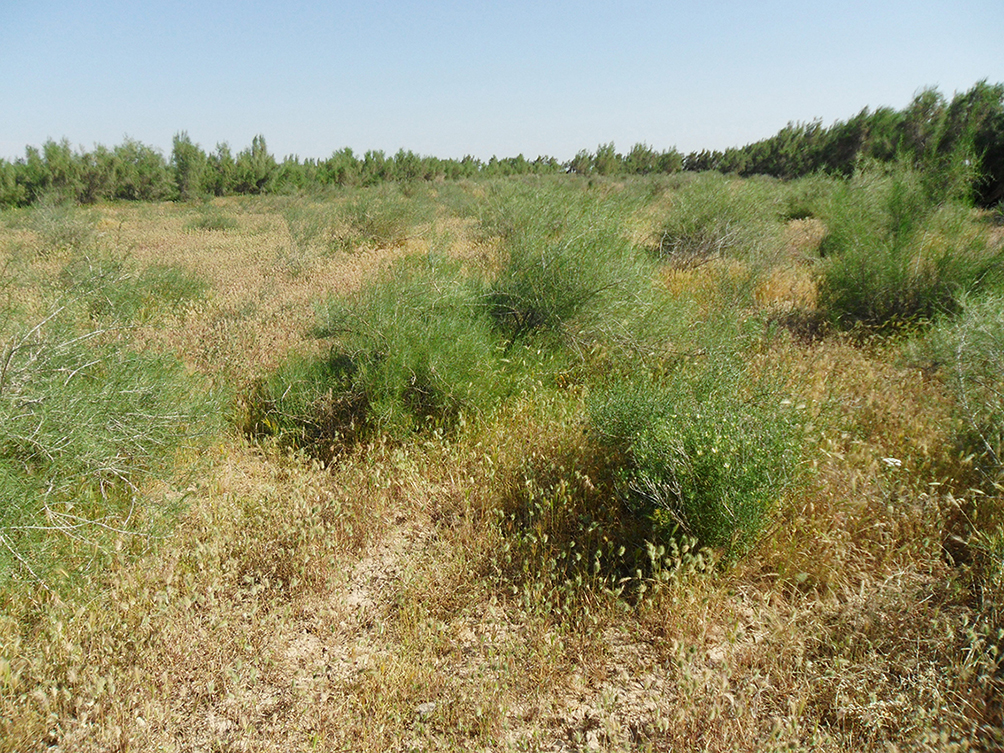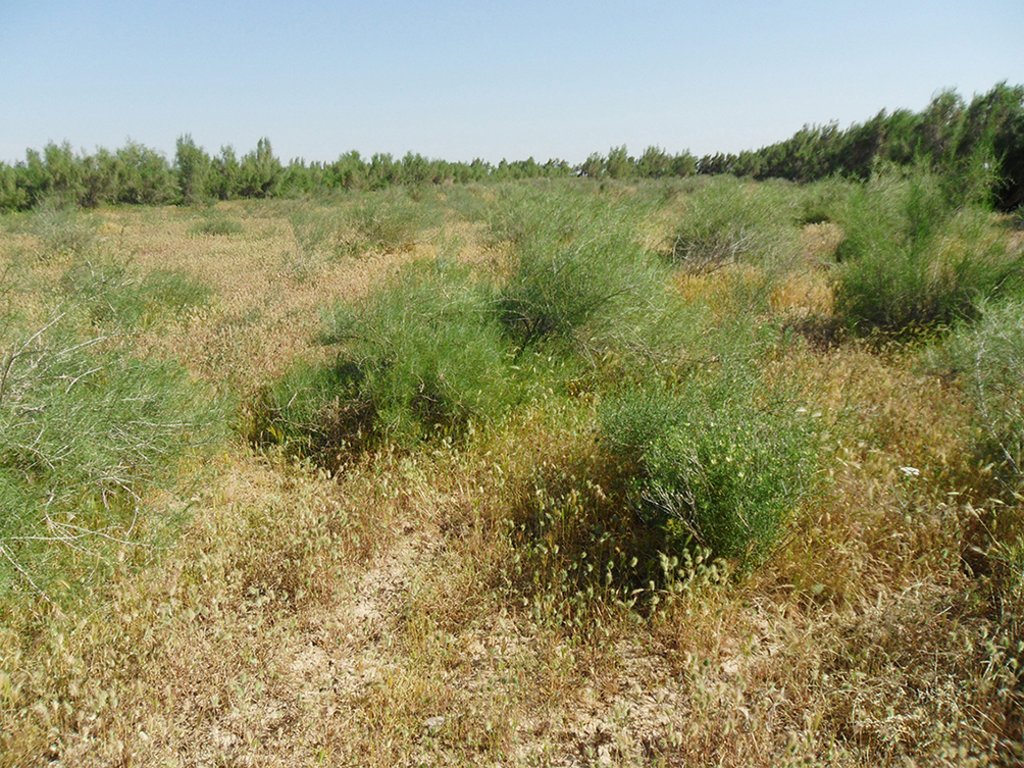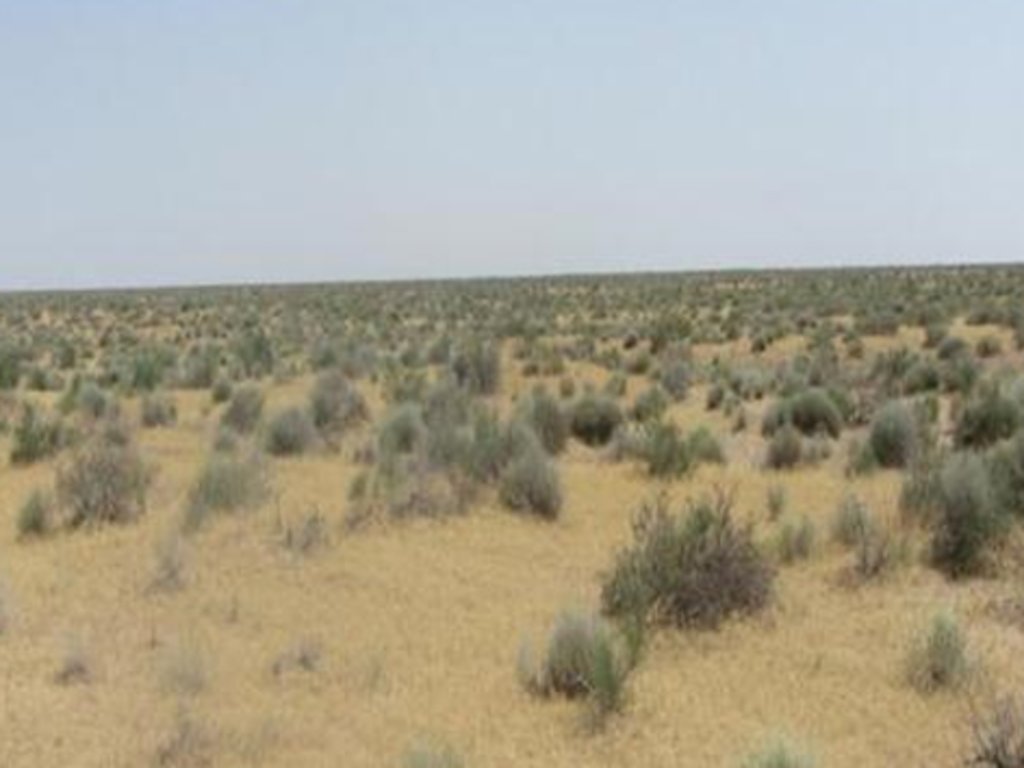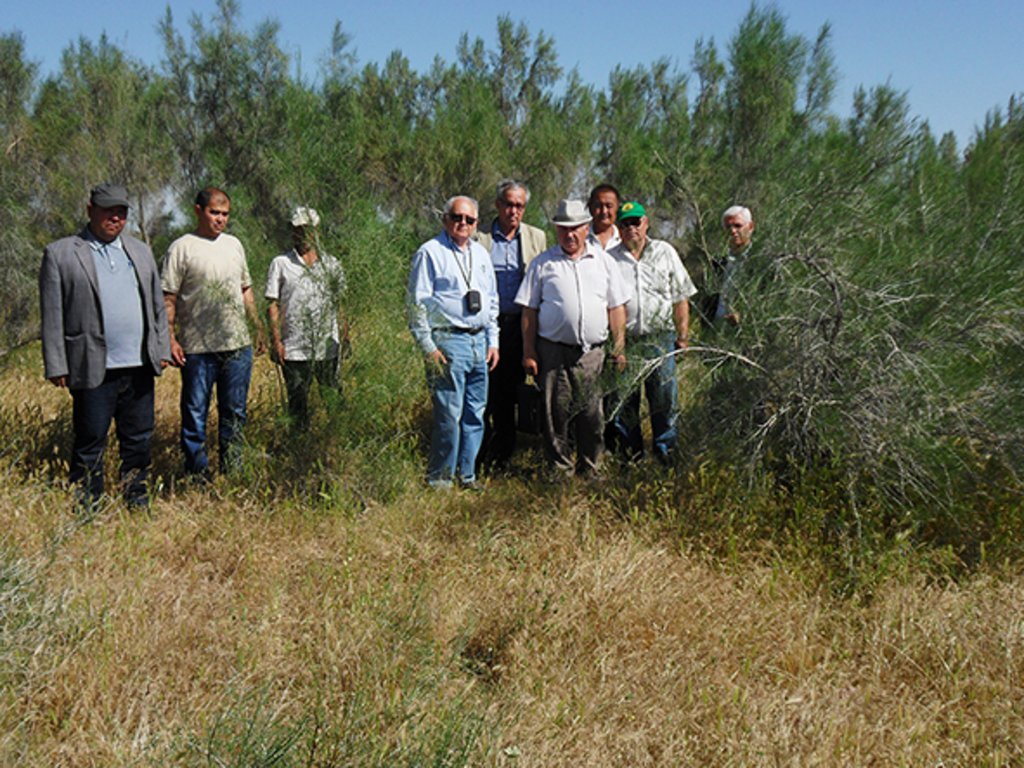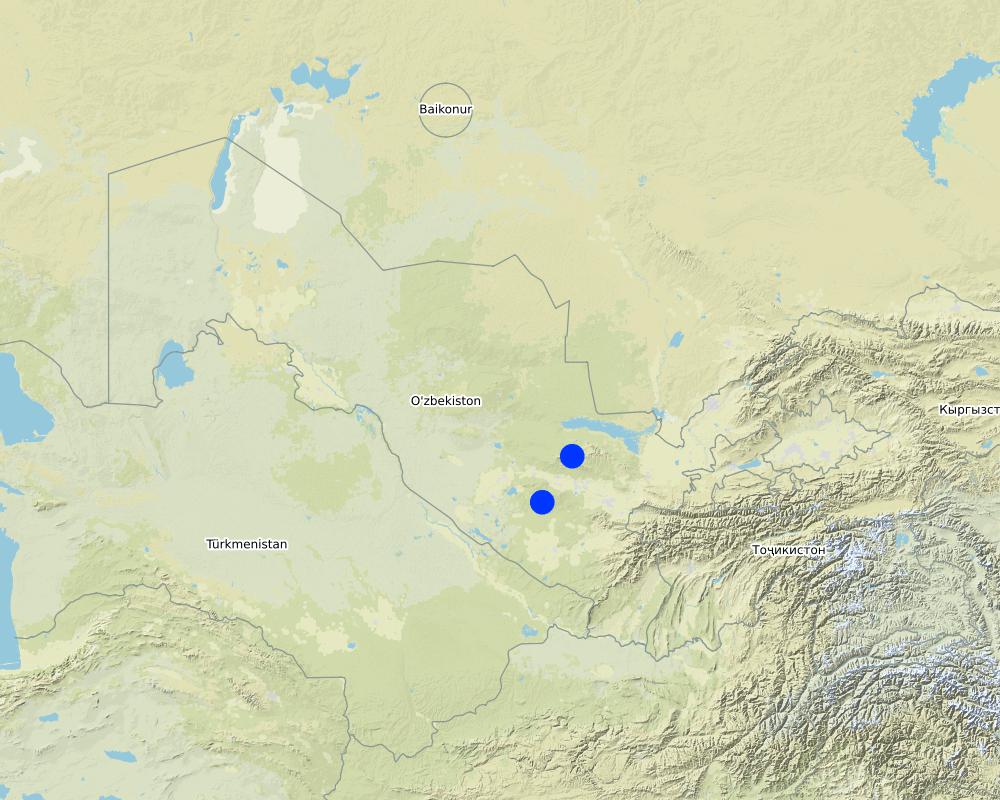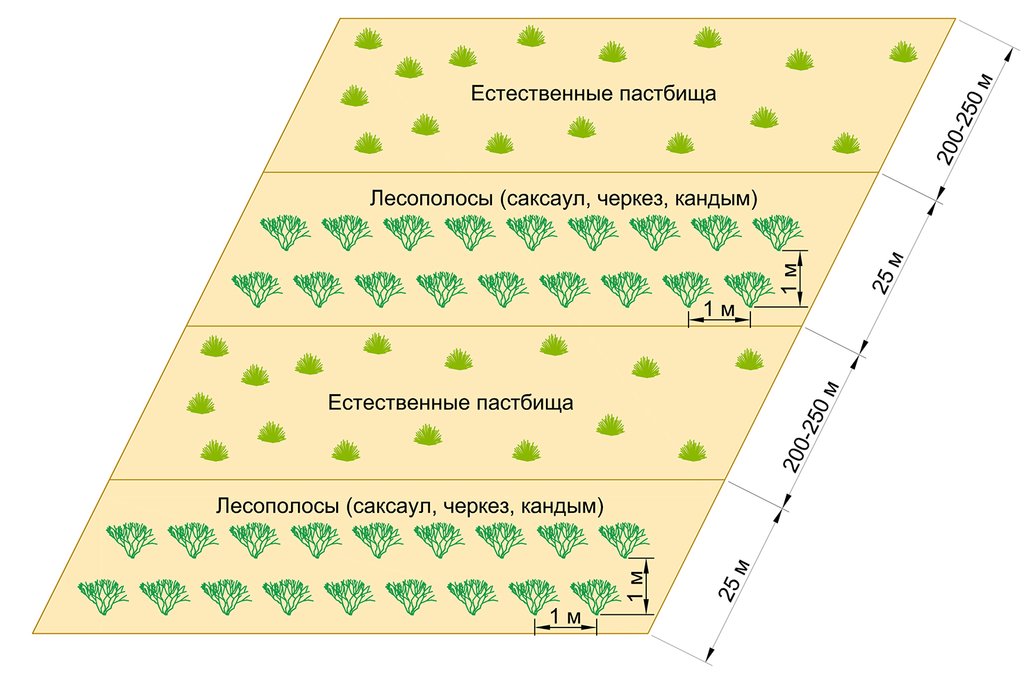Pasture shelterbelts in the desert zone [Uzbekistan]
- Creation:
- Update:
- Compiler: Rustam Ibragimov
- Editor: –
- Reviewers: Elizaveta Soloveyva, Olga Andreeva, Alexandra Gavilano
Pasture shelterbelts in the desert zone
technologies_4037 - Uzbekistan
View sections
Expand all Collapse all1. General information
1.2 Contact details of resource persons and institutions involved in the assessment and documentation of the Technology
Key resource person(s)
SLM specialist:
Bobokulov Nasillo, Asadovich
Research Institute of Karakul Breeding and Desert Ecology
Uzbekistan
SLM specialist:
Mukimov Tolib Hudaikulovich
Research Institute of Karakul Breeding and Desert Ecology
Uzbekistan
SLM specialist:
Rabbimov Abdullo, Rabinovich
Research Institute of Karakul Breeding and Desert Ecology
Uzbekistan
Name of project which facilitated the documentation/ evaluation of the Technology (if relevant)
Decision Support for Mainstreaming and Scaling out Sustainable Land Management (GEF-FAO / DS-SLM)1.3 Conditions regarding the use of data documented through WOCAT
The compiler and key resource person(s) accept the conditions regarding the use of data documented through WOCAT:
Yes
1.4 Declaration on sustainability of the described Technology
Is the Technology described here problematic with regard to land degradation, so that it cannot be declared a sustainable land management technology?
No
2. Description of the SLM Technology
2.1 Short description of the Technology
Definition of the Technology:
Creation of pasture-protective forest shelterbelts promotes ecological and phytocenotic compatibility of natural vegetation and forage plants. The pasture plant community structure improves and the forage capacity of desert pastures increases.
2.2 Detailed description of the Technology
Description:
Pasture livestock in Uzbekistan is located in regions with low natural resource potential on an area of 21.2 million hectares, of which 81.4% are in the desert belt (chul). The desert climate is very hot, arid, with an average rainfall of about 100-250 mm / year. In summer, the air temperature rises to +45, + 50С, and the surface heats up to + 80С. The vegetation cover under these conditions is sparse, consists of ephemeral and semi-shrub vegetation adapted to a hot and dry climate. Ephemeral plants vegetate in a short wet period and die off in early summer. Disturbed vegetation is restored slowly for a long time. Currently, the pasture capacity is exceeded due to the total head of livestock, seasonal use of pastures, lack of pasture rotation. For the livestock farming development it is necessary to ensure the reproduction of pasture products to create a forage base. Pasture-protected forest shelterbelts are an effective method of improving natural pastures in the Chul zone. Shelterbelts create facilities for growth and development of native vegetation (soften the microclimate, contribute to the accumulation of soil moisture during the growing season, reduce the speed of winds, protect the soil from deflation). Pasture shelterbelts consist of large shrubs (saxaul, Circassian and kandym), their width is 25 m wide, density is 600-1200 pcs / ha. The bands are directed perpendicular to the direction of the prevailing winds on flat massifs, and across slopes and ridges on adyrs. Natural pastures are located between the strips, 200-250 m wide. With this arrangement, for every 100 hectares of pastures, there are 10.0-12.5 hectares of protective shelterbelts. Shrubs produce 10-12 kg / ha of phytomass and are a guaranteed autumn-winter feed for sheep and camels. The technology is developed and applied by the research Institute of Karakul breeding and desert ecology to restore and improve the natural ephemeral-ephemeroid vegetation cover on degraded pastures.
The creation of forest shelterbelts includes the following activities:
1. Autumn-winter plowing is carried out simultaneously with harrowing, rolling with ring rollers or leveling. The depth of plowing is 20-22 cm on slightly and medium saline sandy and loamy soils, on shallow gypsum soils – is 15 cm.
2. Sowing. It is recommended to sow black saxaul, Circassian, Kandym from mid-December to mid-February.
The sowing period depends on the meteorological conditions of the year, so the optimal timing is set on the basis of a long-term weather forecast, taking into account the specific weather conditions. Good crops are obtained in rainy weather, under snow or on snow. Sowing is performed by conventional grain and grass seeders, or by scattering seeds manually. To improve flowability, the seeds are mixed with manure and dry sand in a ratio of 1:5. Seeding in the soil is done by rolling ring rollers. The seeding rate is: Haloxylon aphyllum -10-12 kg /ha, Salsola Richteri 8-10 kg / ha, Calligonum 6-7 kg /ha. The technology provides benefits after 3-4 years, and farmers can distribute seeds and expand the area of crops without additional costs.
2.3 Photos of the Technology
General remarks regarding photos:
Photos illustrate the pasture before and after the creation of a protective forest belt
2.5 Country/ region/ locations where the Technology has been applied and which are covered by this assessment
Country:
Uzbekistan
Region/ State/ Province:
Nurabad district/Samarkand region, nuratinsky district/Navoi region
Further specification of location:
Nurabad district/Carnaby, Nurata district/Nurata
Specify the spread of the Technology:
- evenly spread over an area
If precise area is not known, indicate approximate area covered:
- 0.1-1 km2
Comments:
The Technology is used in degraded pasture areas to increase land productivity
Map
×2.6 Date of implementation
Indicate year of implementation:
2003
If precise year is not known, indicate approximate date:
- 10-50 years ago
2.7 Introduction of the Technology
Specify how the Technology was introduced:
- during experiments/ research
- through projects/ external interventions
Comments (type of project, etc.):
The Technology is being implemented within the framework of the Institute of Karakul breeding and desert ecology and through projects aimed at pasture management improving
3. Classification of the SLM Technology
3.1 Main purpose(s) of the Technology
- improve production
- reduce, prevent, restore land degradation
- preserve/ improve biodiversity
3.2 Current land use type(s) where the Technology is applied

Grazing land
Extensive grazing:
- Semi-nomadic pastoralism
- Small and large cattle, wool, karakul and meat, milk
3.3 Has land use changed due to the implementation of the Technology?
Comments:
no change
3.4 Water supply
Water supply for the land on which the Technology is applied:
- rainfed
Comments:
Number of growing seasons per year: 2
Specify:
Natural and climatic conditions of Uzbekistan allow to get 2 crops per year of short growing season crops (vegetables, potatoes), or when they are cultivated after harvesting winter wheat. Major crops - cotton and wheat produce 1 crop / year.
3.5 SLM group to which the Technology belongs
- windbreak/ shelterbelt
- improved ground/ vegetation cover
3.6 SLM measures comprising the Technology

vegetative measures
- V1: Tree and shrub cover
3.7 Main types of land degradation addressed by the Technology

soil erosion by water
- Wt: loss of topsoil/ surface erosion

soil erosion by wind
- Et: loss of topsoil
- Ed: deflation and deposition
Comments:
Water, wind erosion and biological degradation are caused by natural factors (low rainfall, high temperatures and evaporation from the soil) and irrational pastures management (exceeding the pasture capacity, lack of rotation), which lead to the degradation of the vegetation cover, and increase the proportion of bare/unprotected surface, increasing the risk of erosion.
3.8 Prevention, reduction, or restoration of land degradation
Specify the goal of the Technology with regard to land degradation:
- reduce land degradation
Comments:
Shelterbelts create facilities for growth and development of native vegetation (increase the vegetative cover density, soften the microclimate, contribute to the accumulation of soil moisture during the growing season, reduce the speed of winds, protect the soil from deflation).
4. Technical specifications, implementation activities, inputs, and costs
4.1 Technical drawing of the Technology
Technical specifications (related to technical drawing):
Pasture shelterbelts consist of large shrubs (Haloxylon, Salsola and Calligonum), with the 25 m width, 600-1200 pcs / ha density. Natural pastures are located between the strips, 200-250 m wide. With this arrangement, for every 100 hectares of pastures, there are 10.0-12.5 hectares of protective belts. The bands are directed perpendicular to the direction of the prevailing winds on flat massifs, and across slopes and ridges on adyrs.
Author:
R. Ibragimov
Date:
05/09/2018
4.2 General information regarding the calculation of inputs and costs
Specify how costs and inputs were calculated:
- per Technology area
Indicate size and area unit:
1 ha
Specify currency used for cost calculations:
- USD
If relevant, indicate exchange rate from USD to local currency (e.g. 1 USD = 79.9 Brazilian Real): 1 USD =:
4500.0
Indicate average wage cost of hired labour per day:
for about 10 USD
4.3 Establishment activities
| Activity | Timing (season) | |
|---|---|---|
| 1. | Soil preparation: plowing, harrowing, leveling | December-February |
| 2. | Sowing | Mid-December-mid-February |
| 3. | Crop care: pest and weed control | March-September |
Comments:
Pasture-protected forest belts are planted in winter. Sowing is recommended in rainy weather, under the snow or in the snow
4.4 Costs and inputs needed for establishment
| Specify input | Unit | Quantity | Costs per Unit | Total costs per input | % of costs borne by land users | |
|---|---|---|---|---|---|---|
| Labour | Hired labor for crops care, harvesting | USD/ha | 1.0 | 35.0 | 35.0 | |
| Equipment | Use of machinery (tillage, sowing) | USD/ha | 1.0 | 135.0 | 135.0 | |
| Plant material | Seeds | USD/ha | 1.0 | 55.0 | 55.0 | |
| Total costs for establishment of the Technology | 225.0 | |||||
| Total costs for establishment of the Technology in USD | 0.05 | |||||
If land user bore less than 100% of costs, indicate who covered the remaining costs:
Funds from the budget of the Institute/project
4.5 Maintenance/ recurrent activities
| Activity | Timing/ frequency | |
|---|---|---|
| 1. | To control grazing, the pasture capacity, to prevent over-grazing | constantly |
Comments:
Only management measures preventing overgrazing are required to maintain the Technology. Shelterbelts can be productive for 40-60 years if properly managed.
4.6 Costs and inputs needed for maintenance/ recurrent activities (per year)
Comments:
No additional investment is required to maintain the Technology. Management measures to maintain vegetation cover ensure the productivity of protective forest belts
4.7 Most important factors affecting the costs
Describe the most determinate factors affecting the costs:
The most costs are related to the tillage and the cost of sowing, including fuel. All costs relate to the first year, in subsequent years there are practically no costs.
5. Natural and human environment
5.1 Climate
Annual rainfall
- < 250 mm
- 251-500 mm
- 501-750 mm
- 751-1,000 mm
- 1,001-1,500 mm
- 1,501-2,000 mm
- 2,001-3,000 mm
- 3,001-4,000 mm
- > 4,000 mm
Indicate the name of the reference meteorological station considered:
Karakul
Agro-climatic zone
- arid
The duration of the growing season is 70 days
5.2 Topography
Slopes on average:
- flat (0-2%)
- gentle (3-5%)
- moderate (6-10%)
- rolling (11-15%)
- hilly (16-30%)
- steep (31-60%)
- very steep (>60%)
Landforms:
- plateau/plains
- ridges
- mountain slopes
- hill slopes
- footslopes
- valley floors
Altitudinal zone:
- 0-100 m a.s.l.
- 101-500 m a.s.l.
- 501-1,000 m a.s.l.
- 1,001-1,500 m a.s.l.
- 1,501-2,000 m a.s.l.
- 2,001-2,500 m a.s.l.
- 2,501-3,000 m a.s.l.
- 3,001-4,000 m a.s.l.
- > 4,000 m a.s.l.
Indicate if the Technology is specifically applied in:
- not relevant
5.3 Soils
Soil depth on average:
- very shallow (0-20 cm)
- shallow (21-50 cm)
- moderately deep (51-80 cm)
- deep (81-120 cm)
- very deep (> 120 cm)
Soil texture (topsoil):
- coarse/ light (sandy)
- medium (loamy, silty)
Soil texture (> 20 cm below surface):
- coarse/ light (sandy)
Topsoil organic matter:
- low (<1%)
5.4 Water availability and quality
Ground water table:
5-50 m
Availability of surface water:
poor/ none
Water quality (untreated):
poor drinking water (treatment required)
Is water salinity a problem?
Yes
Specify:
There are no surface water sources. The mineralized water for livestock watering is used from artesian wells.
Is flooding of the area occurring?
No
Comments and further specifications on water quality and quantity:
Water in surface sources is polluted from drainage runoff discharges from irrigation fields
5.5 Biodiversity
Species diversity:
- medium
Habitat diversity:
- medium
Comments and further specifications on biodiversity:
Ephemeral herbs such as Artemisia, Salsola grow in rocky and clay deserts. Salt-tolerant plants (halophytes) dominate in saline massifs. In loess soil deserts the ephemeral grasses prevail, burning out with the beginning of summer heat. Sparse vegetation of sandy deserts is formed by psammophyte grasses.
5.6 Characteristics of land users applying the Technology
Sedentary or nomadic:
- Sedentary
Market orientation of production system:
- mixed (subsistence/ commercial)
Off-farm income:
- > 50% of all income
Relative level of wealth:
- average
Individuals or groups:
- individual/ household
Level of mechanization:
- mechanized/ motorized
Gender:
- men
Age of land users:
- middle-aged
5.7 Average area of land used by land users applying the Technology
- < 0.5 ha
- 0.5-1 ha
- 1-2 ha
- 2-5 ha
- 5-15 ha
- 15-50 ha
- 50-100 ha
- 100-500 ha
- 500-1,000 ha
- 1,000-10,000 ha
- > 10,000 ha
Is this considered small-, medium- or large-scale (referring to local context)?
- medium-scale
Comments:
The average farm size is 35-75 ha in the irrigated zone and more than 100 -200 ha in the pasture non-irrigated zone.
5.8 Land ownership, land use rights, and water use rights
Land ownership:
- state
Land use rights:
- leased
- через ассоциации водопользователей и управления ирригационных систем
5.9 Access to services and infrastructure
health:
- poor
- moderate
- good
education:
- poor
- moderate
- good
technical assistance:
- poor
- moderate
- good
employment (e.g. off-farm):
- poor
- moderate
- good
markets:
- poor
- moderate
- good
energy:
- poor
- moderate
- good
roads and transport:
- poor
- moderate
- good
drinking water and sanitation:
- poor
- moderate
- good
financial services:
- poor
- moderate
- good
6. Impacts and concluding statements
6.1 On-site impacts the Technology has shown
Socio-economic impacts
Production
crop production
fodder production
fodder quality
Income and costs
farm income
Socio-cultural impacts
food security/ self-sufficiency
Ecological impacts
Water cycle/ runoff
harvesting/ collection of water
Biodiversity: vegetation, animals
Vegetation cover
biomass/ above ground C
plant diversity
animal diversity
Climate and disaster risk reduction
drought impacts
wind velocity
6.2 Off-site impacts the Technology has shown
Specify assessment of off-site impacts (measurements):
Technology has a positive off-site impact
6.3 Exposure and sensitivity of the Technology to gradual climate change and climate-related extremes/ disasters (as perceived by land users)
Gradual climate change
Gradual climate change
| Season | increase or decrease | How does the Technology cope with it? | |
|---|---|---|---|
| annual temperature | increase | very well | |
| seasonal temperature | summer | increase | well |
| annual rainfall | decrease | well | |
| seasonal rainfall | spring | decrease | well |
| seasonal rainfall | summer | decrease | well |
Climate-related extremes (disasters)
Climatological disasters
| How does the Technology cope with it? | |
|---|---|
| heatwave | well |
| drought | well |
Other climate-related consequences
Other climate-related consequences
| How does the Technology cope with it? | |
|---|---|
| extended growing period | very well |
6.4 Cost-benefit analysis
How do the benefits compare with the establishment costs (from land users’ perspective)?
Short-term returns:
slightly positive
Long-term returns:
very positive
How do the benefits compare with the maintenance/ recurrent costs (from land users' perspective)?
Short-term returns:
slightly positive
Long-term returns:
very positive
Comments:
The Technology is low-cost, so the profit is obtained in the short term.
6.5 Adoption of the Technology
- 1-10%
Of all those who have adopted the Technology, how many did so spontaneously, i.e. without receiving any material incentives/ payments?
- 0-10%
6.6 Adaptation
Has the Technology been modified recently to adapt to changing conditions?
No
6.7 Strengths/ advantages/ opportunities of the Technology
| Strengths/ advantages/ opportunities in the land user’s view |
|---|
| The Technology is uncomplicated, all measures for tillage, sowing and crpo care are well known |
| Local species of forage plants are used |
| Strengths/ advantages/ opportunities in the compiler’s or other key resource person’s view |
|---|
| The Technology is uncomplicated, all measures for tillage, sowing and crpo care are well known |
| Local species of forage plants are used |
6.8 Weaknesses/ disadvantages/ risks of the Technology and ways of overcoming them
| Weaknesses/ disadvantages/ risks in the land user’s view | How can they be overcome? |
|---|---|
| Lack of awareness among farmers and the local people | Trainings and awareness raising for key stakeholders |
| The farmers unwillingness to alienate parts arable lands for pastures and forest belts. (i.e. long-term benefits) | Preparation and dissemination of instructions and recommendations on pasture phytomelioration and creation of pasture protected forest belts |
| Measures on pasture-protective forest belts creation are not defined at the state level because of poor assessment of phytomelioration efficiency. | Involve local people in the creation of pasture protective forest belts and pasture phytomelioration |
| Stakeholder responsibilities are not defined | It is necessary to take measures on phytomelioration development and creation of pasture-protective forest belts at the state level (orders of the Ministries, Resolutions, etc.). It is necessary to determine the responsibilities of the parties, as well as measures to encourage farmers who have already created pasture-protected forest belts and introduced fodder crops. |
| Absence of state or public structures promoting the pasture phytomelioration development | Creation of phytomelioration demonstration plots and creation of pasture-protective forest belts |
| Weaknesses/ disadvantages/ risks in the compiler’s or other key resource person’s view | How can they be overcome? |
|---|---|
| Lack of information and knowledge about pasture phytomelioration | Pasture protective forest belts are created in Kanimeh district of Navoi region along highways |
| Some farmers know the features and benefits of technology | Pasture protective forest belts are created In Farish district of Jizzakh region on the area of 10 ha |
7. References and links
7.1 Methods/ sources of information
- interviews with SLM specialists/ experts
3 persons
- compilation from reports and other existing documentation
7.2 References to available publications
Title, author, year, ISBN:
Yusupov S. Yu., Mukimov T. Pastures of Uzbekistan and their rational use. Tashkent, 2009, 128 p.
Title, author, year, ISBN:
Rabbimov A., Mukimov T. Recommendations on rational use and increase of productivity of desert pastures. Recommendations, Tashkent, 2012, p. 48
Title, author, year, ISBN:
Rabbimov A., Mukimov T. intensification of forage production in the desert -the main way of modernization of desert-pasture livestock. Chal - Yalov carbacholine modernizational muammolari. Republic of Ilmi – Amali of conferencesi of materiallari Samarkand, 2012, pp. 308-315
Title, author, year, ISBN:
Rabbimov A., Mukimov T., Bekchanov B., boboeva A. Phytomelioration of pastures in Uzbekistan and its necessity in combating desertification and degradation Actual issues of development of productive camel breeding in Kazakhstan. Shymkent, 2014, p. 265-269
7.3 Links to relevant online information
Title/ description:
Rabbimov A., Mukimov T., Rabbimov F. Ways of rational nature management on pasture ecosystems of Uzbekistan. International scientific and practical Internet conference "Modern ecological state of the natural environment and scientific and practical aspects of rational nature management" February 29, 2016, - S. Salty zaymishche
URL:
www.pniiaz.ru
Title/ description:
Tolib Mukimov Uzbekistan -- Rangelands and Pasturelands: Problems and Prospects Chapter 12 Rangelands along the Silk Road: Transformative Adaptation under Climate and Global Change. Editors: Victor Roy Squires, Shang Zhan-Huan and Ali Ariapour (International Dryland Management Consultant, Adelaide, Australia, and others) NOVA, 2017, 217-231 р.
URL:
https://www.novapublishers.com/catalog/product_info.php?products_id=60416
Links and modules
Expand all Collapse allLinks
No links
Modules
No modules


